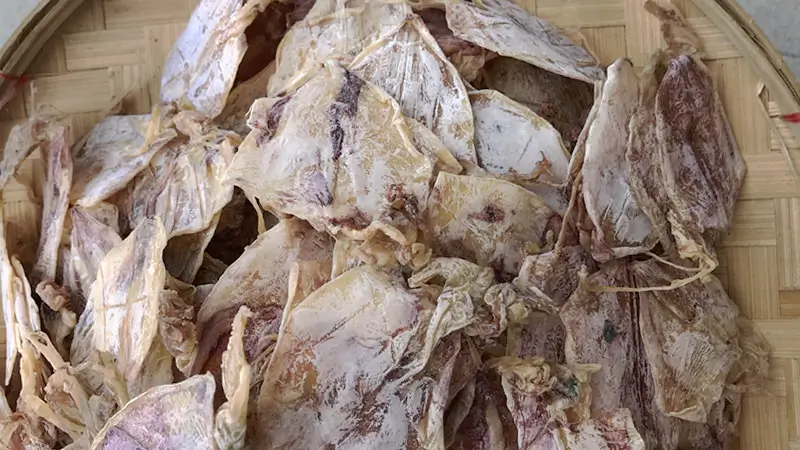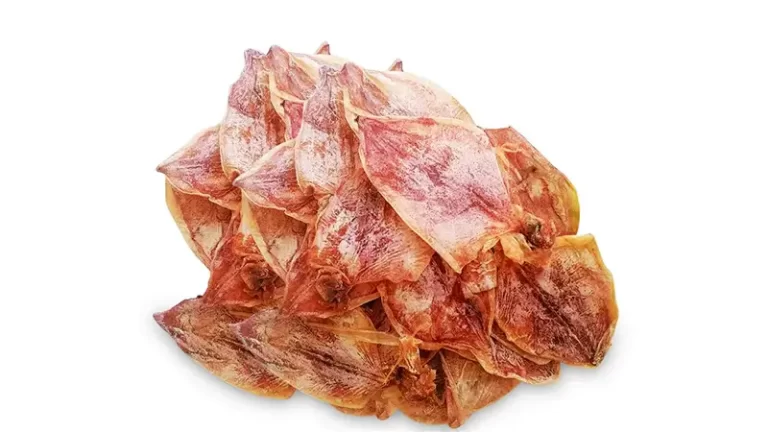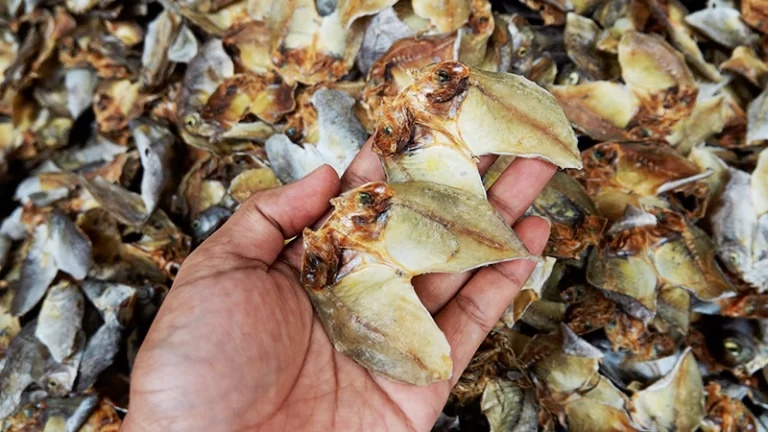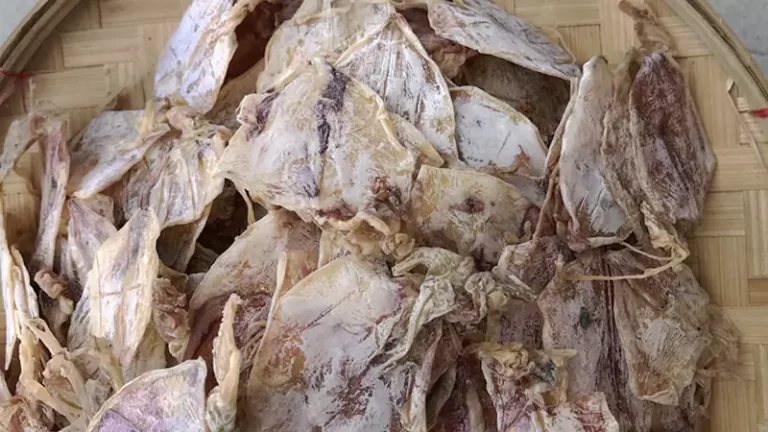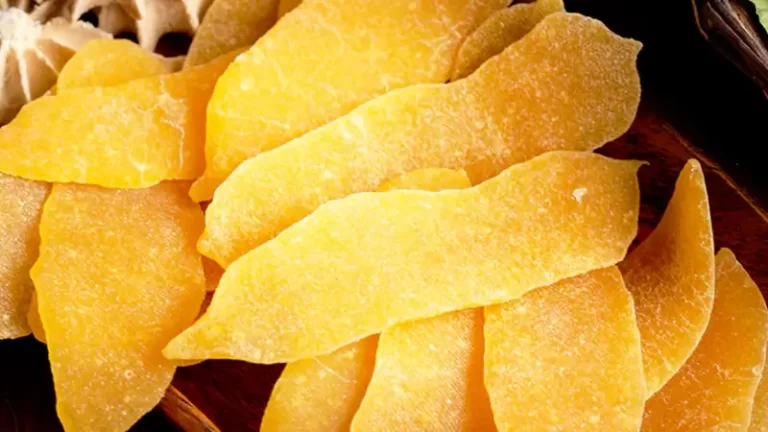Squid (pusit) is one of the most popular seafood in the world. Like any seafood, squid is versatile, and can be boiled, braised, seared, grilled, and dried. In Asian countries like Korea, Japan, China, and the Philippines, dried squid is a popular choice not only for its flavor but also for its affordability.
In the Philippines, arguably one of the best products of dried squid is Cebu. Famous for producing delicious delicacies like dried mangoes, lechon, and danggit, another must-try delicacy is the Cebu dried posit from Bantayan Island, north of Cebu.
But, what is dried squid? How is it made? What does it taste like? How do you cook it? Where can you buy Cebu dried pusit? How much does it cost? Keep reading to discover everything you need to know about Cebu dried pusit!
What is Dried Squid (Dried Pusit)?
Dried squid (dried pusit) is made from cleaned fresh squids which are then sun-dried. Another variation, the dried shredded squid, is a dried, shredded, and seasoned seafood product. Both are made from squid.
Dried squid is a popular product throughout the world, but most especially in Asian countries, including the Philippines. In the country, arguably one of the best dried squid is the Cebu dried pusit.
History and Origins
Historically, squid is common in Pacific coastal regions of East Asia and Southeast Asia. After the packaged form began shipping to English-speaking regions, the Japanese word surume and yóu yú sī in Chinese for this form of seafood was translated as “dried shredded squid” and imprinted on packages.
The snack was popularized, sold, and consumed regularly in Hong Kong during the 1970s. Shredded squid began being sold in Macau as an addition to their almond biscuit. In China, it is usually considered to be a light snack, sold in bags in many department stores in major cities. In Japan, dried shredded squid is popularly served as an otsumami (snack consumed while drinking alcohol).
In Korean cuisine, dried shredded squid is eaten as anju (food to eat while drinking) and as banchan (small side dishes), such as the dish ojingeochae bokkeum, which is made by stir-frying dried shredded squid seasoned with a mixture of gochujang (chili pepper paste), garlic, and mullyeot (corn syrup-like condiment).
In Singapore, it was also popular amongst the older generation when it was sold in a Mama shop. It was marketed as the Chewing gum of the Orientals by the food manufacturing company Ken Ken in the 1970s, before the chewing gum ban in Singapore in 1992.
How Is Dried Pusit or Dried Squid Made
You can buy Cebu dried pusit or, alternatively, you can make your own dried squid using several drying methods. Similar to meat and other seafood, pusit are dried to lengthen their shelf life.
Here are some dried pusit drying methods that you can try:
Sun-drying
Sun-drying is the most common method of making dried pusit. Simply wash the squid thoroughly and split and remove internal organs. Then, spread the washed squid meat on drying trays, pat dry with a paper towel, and dry under the sun. Always remember to turn it over once or twice to keep the dryness consistent.
Using a dehydrator
Aside from sun-drying, you can use a dehydrator to make the process of making dried pusit easier and faster. Before dehydrating, just remember to blanch the squid in a large pot of boiling water and shake it dry. Then, put it in the dehydrator at low to medium heat, around 70-90 C. This method might make your dried squid very chewy and not tender.
Here’s a step-by-step guide to help you prepare your own dried pusit.
Ingredients:
- Squid
- Salt
Procedure:
- Sort out the squid according to size (small, medium, and large) small size ranges from 25-30 cm long, medium size ranges from 31-35 cm, and large from 36-40 cm.
- Manually clean the squid thoroughly by removing the eyes, skin, mouth, and fins using salt or tap water.
- Slit open the underneath portion of the squid entrails.
- Sundry cleaned squid inside out from 8:00 am to 3:00 pm using a dryer made a bamboo mat known as capping.
- Collect the sun-dried then air-dry for an hour under the shade.
- Sun-dry the squid again from 4:00 pm to 5:00 pm.
- Collect the squid late in the afternoon when the temperature is low to prevent the squid from sticking to the dryer.
- Sun-dry squids the following day, this time outside out.
- Flatten the body and tentacles of the squid by spreading some oil and rolling a bottle over it.
- Pack the squid as you like.
Processing of Dried Pusit of Dried Squid (Ichiban dried squid)
- Preparation. Fresh squid is cut longitudinally in the center of the abdomen. The head is cut in the center and the organs and eyes are removed. The fins, skin, soft shell, and beak remain.
- Washing. The prepared squid is first washed in seawater to remove contaminants, which adhere, and it is then washed in fresh water to remove the salt.
- Drying-shaping. There are various drying methods, including suspension drying and skewer drying, but hanging drying is usually employed. Ropes are stretched and the prepared, washed squid are hung in places with good exposure to sunlight. The arms are separated and extended to facilitate drying. The squid is left on the ropes at night since air circulation is good even then.
The squid is removed from the rope the next day, extended, and shaped. The squid is then spread on a straw mat with their backs upward, and they are dried in the sun. They are inverted during drying to continue the process and packed in boxes with a plastic layer at night. The next day, they are removed and again extended and shaped. They are stretched on straw mats until sufficiently dried.
After drying the squid, make sure to pack it in a plastic bag and store it in a cool and dry place. The most common distribution method in today’s Asian countries is the prepackaged format. The bags are usually sealed airtight to keep the squid chewy and tough. However, you can also buy unpackaged versions of Cebu dried pusit – you’ll especially find a lot of it at Cebu Taboan Market.
Dried Squid Benefits
Overall, squid is good for the body. Moreover, drying the squid doesn’t change its taste or nutritional value – drying it only preserves its scent and tastes better.
Dried squid contains high-quality protein, fatty acids, and amino acids. Squid has polyunsaturated fatty acids (Omega-3) that help soothe the symptoms of rheumatoid arthritis. This popular seafood dish also doesn’t contain many carbohydrates. It is perfect for those who prefer to consume limited carbohydrates and for those on a keto diet.
However, like any food, squid should be consumed in moderation. Squid contains high dietary cholesterol that might increase your risk for heart disease. In addition, you need to watch out for other health risks like high mercury levels and allergies.
What Does Dried Pusit Taste Like?
The taste of dried pusit can change depending on the manufacturer. Some dried pusit may taste sweet, others are salty and spicy. Texture-wise, most dried squid can go from beef jerky chewy texture to extra tender and dry.
Dried pusit can also be combined with other dishes to create a fusion of flavors. The drying process enhances the flavor of the squid, making it heavenly in strengthening the flavor of dishes.
If you’re looking for some of the best-tasting pusit that the country has to offer, make sure to try Cebu dried pusit!
How to Cook Dried Pusit or Dried Squid
Aside from frying it, there are many other ways to cook dried squid. Here are some Cebu dried pusit recipe ideas you can try!
4 of the Best Recipe Ideas That You Can Try
Ingredients:
- Dried Squid
- Cooking Oil
Instructions:
- Soak dried squid in water for 30 minutes to soften before frying. Dry thoroughly with a paper towel before cooking.
- Heat oil over medium-low heat.
- Place dried squid and lower heat to low.
- Slow cook each side for 3 minutes. Use the kitchen utensil to flatten the squid. If you don’t do this it will curl and will not cook evenly.
- Before removing from the pan adjust the heat to medium. Cook for another minute to crispy the dried squid.
- Transfer to a plate lined with a paper towel. Let it rest for a few minutes and it will get crispier.
- Serve with vinegar dip or any pickled vegetable. Enjoy!
Ingredients:
- 1/2 lb. large dried squid
- 2 cups coconut cream
- 3 pieces long green chilies sliced
- 1 teaspoon minced garlic
- 1 tablespoon minced ginger
- 1 medium onion minced
- 2 tablespoons fish sauce
- 1/4 teaspoon ground black pepper
- 1 bunch of fresh spinach
Instructions:
- Heat up the grill. Once the grill gets hot, grill one side of the squid for 3 minutes. The squid will curl up, try to straighten the other side (if possible), and grill for 1 to 2 minutes. Set aside.
- Arrange the coconut cream, ginger, onion, garlic, green chilis, squid, ground black pepper, and fish sauce in a slow cooker. Set the slow cooker to high, cover, and slow-cook the squid for 8 hours.
- Add the spinach. Cook for 10 to 15 minutes.
- Transfer to a serving bowl.
- Serve. Share and enjoy!
Ingredients:
- 2 dried squid
- 1/4 pineapple
- 1 tbsp chili sauce
- 1 tbsp of ketchup
- 1 tbsp sugar
- 1 tbsp fish sauce
- 1 garlic
- 1 teaspoon paprika
- 1 tbsp Cooking oil
- 20 g of roasted sesame seeds
Instructions:
- Bake the squid on a charcoal or gas stove until you smell the aroma. Grill until cooked evenly on both sides. Pack the squid on a sheet of paper and use a heavy object to soften it, then tear the piece to taste.
- Make the sweet and sour sauce: pineapple juice, sugar, chutney, ketchup, oyster sauce, and fish sauce.
- Simmer squid with sauce and paprika until thickened. Season to taste, if not sour then adds tamarind or vinegar to taste.
- When the squid is dry, mix the roasted sesame seeds.
Ingredients:
- 1/4 kilo of dried squid
- 5 cloves of garlic
- 3 cups of rice
- 3 eggs beaten and scrambled
- 2 tsp. vinegar
- Cooking oil
- Salt and pepper to taste
Instructions:
- Fry the dried squid until crispy. Drain the excess oil by placing it on a paper towel.
- Then cut it into thin strips or just shred it to pieces.
- Reduce the oil to just about a tablespoon in the pan where you fried the dried pusit.
- Then sauté the garlic until fragrant and golden brown.
- Add in the rice then stir fry and let all the ingredients mix together thoroughly.
- If the rice is too dry, don’t be afraid to add a little water or chicken stock.
- This will make the rice softer and more enjoyable to eat.
- Then toss the scrambled eggs into the fried rice.
- Stir fry again to mix the beaten eggs with the rice.
- Then last but not least, season with a dash of salt and pepper and drizzle with vinegar.
- Korean Spicy Dried Squid
Ingredients:
- 4 oz (110g) dried squid strips (ojingeochae)
- Sesame seeds
- Sauce for Ojingeochae Muchim
- 1 Tbs gochujang
- 1 Tbs rice wine (mirin)
- 2-3 tsp gochukaru (Korean red chili powder)
- 2 tsp soy sauce (jin ganjang – kikkoman will do)
- 1 tsp sugar
- 1/2 tsp garlic powder
- 1 Tbs maple syrup
- 1 tsp mayonnaise
Instructions:
- Boil hot water (about 2 cups). Put the squid in a metal colander or sieve. Gently pour hot water over the dried squid strips. This process softens the squid but also removes some of the seasonings, making it less salty. Skip this step if you prefer chewy ojingeochae. If you do skip, also remember to use less soy sauce.
- Mix gochujang, gochukaru, sake, soy sauce, sugar, garlic powder, and maple syrup to make seasoning for the dried squid recipe.
- Heat the pan on medium-low heat and simmer the seasoning sauce for 2 minutes. Stir a few times. We don’t want to reduce the sauce, just cook the raw taste out of it.
- Turn the heat to LOW. Toss and mix dried squid strips with the sauce. Mix until squid strips are evenly coated. Turn OFF the heat.
- Mix in 1 tsp of mayonnaise. Also, if you are using corn syrup, this time is when you will be adding it also. Adding mayonnaise is optional. It does kind of round out the seasoning and also keeps everything moister but flavor-wise, it is really not that noticeable in my opinion.
- Sprinkle lots of sesame seeds on top and that’s it!
Cebu Dried Pusit Price
The cost of Cebu dried pusit varies from one seller to another. It also depends on how many kilos you purchase. Typically, Cebu dried pusit can cost anywhere from Php 250 – Php 1,000+, depending on your order.
Where to Buy Cebu Dried Pusit
You can buy pre-packaged dried pusit from most grocery stores nationwide. If you’re in Cebu, you can buy fresh and unpackaged Cebu dried pusit from local markets, particularly at Cebu Taboan Market, where you’ll find rows of baskets filled with dried squid.
You can also order Cebu Dried Pusit from the comfort of your home. Simply order it online from BigBuyMall.ph online store thru this link, and have it delivered directly to your designated delivery address whether in your own residential address or in your office.
Their Special Dried Pusit from Bantayan Island Cebu is available nationwide in 1 kg, ½ kg, ¼ kg, and 100 gms packaging.
Go ahead – visit BigBuyMall.ph now to order Special Dried Pusit from Bantayan Island Cebu.
Free Shipping is also offered for orders of 1 kg. or more.

